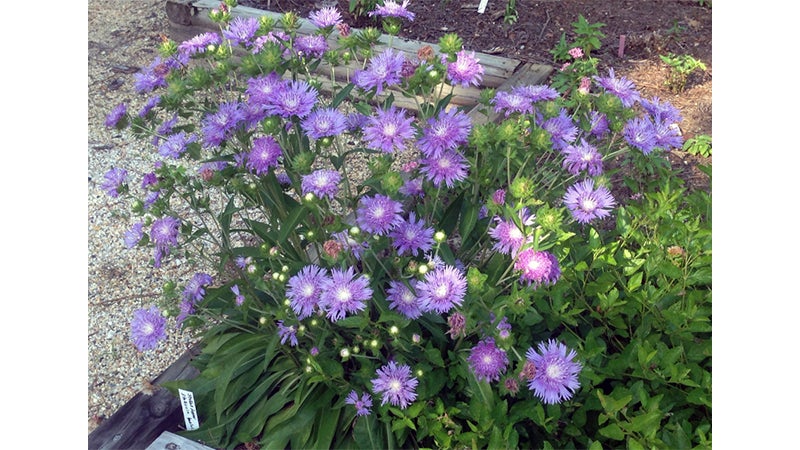Arboretum Paths: Stokes’ Aster—a tough and beautiful native perennial
Published 7:00 am Wednesday, May 10, 2017

- Perennial: Stokesia is a superb performer in the Arboretum’s Children’s Butterfly Garden, which was funded by Pratt & Whitney Rocketdyne at Stennis. Photo by Pat Drackett
By Patricia R. Drackett
Although we’ve had some lovely mild weather recently, we all know that summer will soon be here. For many, the hot weather signals an end – or at least a reduction – to the time we spend outdoors in the garden.
In a perfect world, all of the plants in our garden would perform effortlessly in summer’s heat and humidity. They would reward us with robust blooms, and never need attention.
To some degree, native plants can be low-care choices for your garden. We do nothing to cultivate the beautiful perennials in our Savanna Exhibit! Well, we do burn this area in the wintertime, to maintain the exhibit in a perpetual stage of “early succession.”
Perennials native to our coastal south are adapted to our climate. When located properly, in the environmental conditions they prefer, they usually require little maintenance once they are established.
A garden plant is a clear winner when it will perform in a variety of light and soil conditions. For example, the attractive, purple-flowering Stokes’ Aster (Stokesia laevis) grows in the full sun and moist soils of our Savanna Exhibit, but I’ve also seen this plant blooming in shady woodlands along our coastal streams.
Stokesia is native to acidic coastal wetlands, such as pine flatwoods and savannas. It’s not unusual to spy it in a roadside ditch. Increasingly, the tough native perennial is appearing in garden centers and magazine articles, as it is adaptable and easy to grow.
Stokes’ Aster is considered one of the most attractive late-flowering perennials. Right now it is preparing to bloom in the Arboretum’s Butterfly Garden area. Cut flowers will last indoors a week or more. Use this plant at the front of your perennial borders, where it will maintain a robust rosette of leaves, even in the winter months.
On tours of the Arboretum, we often encounter the lavender blooms of Stokes’ Aster (Stokesia). Like the other species in our Savanna Exhibit, it is fire-tolerant, and pops back just fine and dandy after a prescribed fire.
Many cultivars of Stokesia are available in the trade, with a wide variety of colors. Pinch off the spent flowerheads to encourage repeat flowering. For maximum bloom, locate in full sun. Although the plants prefer moisture, the plant will perform equally well in regular garden soil that is light and well-drained. Keep the soil on the dry side in the winter months.
Many of Mississippi’s wildflowers are at home in hot, wet environments such as the Arboretum’s Savanna Exhibit. If you have an area of your property that is difficult to garden in a traditional manner, you may want to consider letting it go a “little bit wild”. Allow it to grow up and see what develops, or sprinkle in a wildflower mix designed for our region.
For an excellent guide to native wildflowers, visit the MSU Extension website (http://extension.msstate.edu/), and select the Publications (the top menu, to the far right) for Publication No. 1709, “Wildflowers for Mississippi Meadows and Gardens”. Topics such as planting times, soil preparation, seed mixes, and weed control are covered. Lists of perennials and annuals that re-seed for sunny meadows are included, and perennials that are suited for sunny wet areas.
If you’re a fan of wildflowers, you’ll enjoy reading through the many articles available on the MSU Extension website. Enter the key word “wildflowers” in the homepage search field to learn more about Mississippi wildflowers for your garden, including growing tips on how to establish a wildflower garden.
The Arboretum will be hosting a Sharing Nature Teachers’ Workshop on Saturday, June 3 from 9:00 to 3:00 p.m., which is open to all types of teachers, including volunteers, 4-H leaders, and others in teaching roles. The hands-on interdisciplinary workshop will be taught by Mississippi Museum of Natural Science Outreach Educator Sabrina Cummings. Bring a lunch. K-12 educators are eligible for CEU’s.To sign up, please call 601-799-2311 or email your phone no. & organization to pat.drackett@msstate.edu<
For more information, see www.crosbyarboretum.msstate.ed



